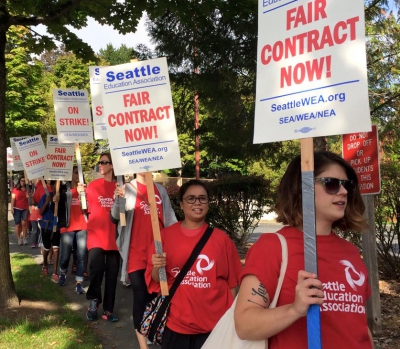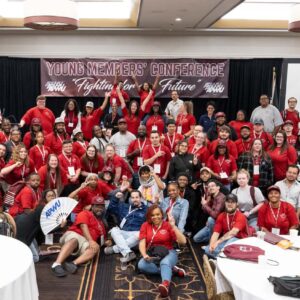November 1, 2015
Young Workers Play Big Role In Seattle Teachers’ Victory
(This article first appeared in the November/December 2015 issue of The American Postal Worker magazine.)

Photo courtesy of Seattle Education Association
Seattle teachers won a strong contract in September after a five-day strike that was marked by overwhelming support from parents, students and the community. Young workers played a leading role in the job action, with a majority of picket captains coming from the ranks of second- and third-year teachers.
The 5,000-member the Seattle Education Association (SEA) represents teachers, nurses, counselors, instructional assistants, office workers and paraprofessionals.
Parent and PTA member Ljiljana Stanojevî-Peñuela organized strike support through a Facebook group, Soup for Teachers, which identified the struggles teachers were facing as broader issues that affect all Seattleites. The group got 1,300 members in less than a week and grew to 2,800 by the strike’s end.
Soup for Teachers brought food to locations near schools, working with rank-and-file strike captains.
Wendy Baier, a retired nurse, commented on the page, “Educators are the most underpaid, disrespected professionals in our country. We must give our teachers everything they need in order to do their jobs,” she wrote. “They are the future of this country and indeed the global community.”
Andy Russell, an elementary school teacher and bargaining team member said, “The spirit was amazing. We had no idea it was going to be as great as it was.”
Russell said that the first day, 95 percent of SEA members were picketing and by day two, participation was up to 97 percent, in addition to community support.
“Parents were coming out of the woodwork. We had students there,” he said.
The new contract includes raises and a cost-of-living increase from the state. In addition, standardized test results will be removed from consideration in teacher evaluations and in establishing caseload caps for nurses and counselors.
Seattle school days will be 20 minutes longer, but teachers will be compensated for the additional time – which management fought during negotiations. The longer day will go into effect the third year of the contract and the extra time will be funded by a local tax.
Can Young Workers Revive Unions?
Union membership rates among “Millennials” may be low, but workers born between the early 1980s and the early 2000s want what unions have demanded for generations, such as fair wages and an end to workplace discrimination.
Only about 4 percent of workers aged 16 to 24 belong to a union, compared to 9 percent of workers aged 25 to 34.
But rather than thinking “Unions, yes!” or “Unions, no!” researchers at Cornell University say young workers are more likely to ask, “Unions, what?” When asked, young workers say that they do not necessarily like or dislike unions, they just don’t know much about them.
However, recent organizing drives among young-worker-dominated media groups like Gawker, Salon and Al Jazeera America may be signs of a changing tide.
“If large numbers of young, educated Millennials followed in these footsteps, the economic impact could be enormous,” Jonathan Timm wrote in The Atlantic.
“According to the Bureau of Labor Statistics, union workers on average make more money and have better access to wages and benefits than nonunion workers. And according to The Century Foundation, a left-leaning think tank, a worker can expect to earn an extra $551,000 in wealth over his or her lifetime simply as a result of joining a union,” he continued.
“Could Millennials revive unions?” Timm asked.



